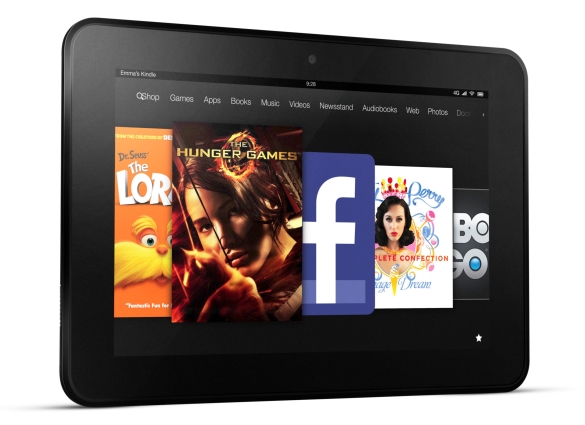Not many companies can make Apple sweat, but Amazon has just turned up the heat with the new Kindle Fire HD tablet/ereader family: The 7-inch Kindle Fire HD ($199 with 16GB of storage; $249 with 32GB), the 8.9-inch Kindle Fire HD 8.9 ($299 with 16GB; $369 with 32GB) and the Kindle Fire HD 8.9 4G LTE Wireless ($499 with 16GB; $599 with 32GB).
The classic 7-inch Kindle Fire, which recently sold out on Amazon.com, is back in the Kindle lineup with a faster processor, more memory and a really cool new feature: A lower $159 price tag.
The 7-inch Kindle Fire HD, which has a better display, more storage space and Dolby stereo audio but the same $199 starting price as the old Kindle Fire, is available for preorder now and will be in stores Sept. 14. The other models will be available Nov. 20.
As a family, the new color Kindle HD units are poised to make a huge impact in three key tech sales areas: the affordable entry-level tablet market, the muscle Wi-Fi tablet segment and in the do-it-all-always-connected-big-tablet competition. Apple may have something interesting in the works as it rolls out a new iPad or two this fall, but for now Amazon has delivered a stunning first punch to the 2012 holiday-season tablet market.
Aside from HD displays, the new Kindle HD units have two Wi-Fi MIMO (Multiple In/Multiple Out) antennas, which means that both antennas can receive data simultaneously on 2.4 GHz or 5 GHz Wi-Fi networks, thus resulting in better wireless Internet reception, according to Amazon.
Also included in the new units are front-facing cameras, a custom version of Skype videoconferencing software, free unlimited cloud storage for Kindle media, Bluetooth wireless adapters for wireless headsets, speakers and other accessories and an HDMI out port.
With a starting price of $299, the Kindle Fire HD 8.9 is far more affordable than the least expensive Apple iPad, but offers an admirable array of features, including its 1,920-by-1,200-pixel, 254-pixel-per-inch IPS display and a 1.5 GHz, dual-core processor. It has the same look as the smaller Kindle HD, which has a 1.2GHz processor, in terms of its dark case and thick border around the display area.
The Kindle Fire HD 4G LTE Wireless offers the same features of the Kindle Fire HD 8.9 plus high speed always-on LTE data service at a very competitive price: $50 a year for 250MB a month data, 20GB of additional cloud storage and a $10 Amazon app store credit.
Even Amazon CEO Jeff Bezos said at the company’s Kindle press conference that Amazon was willing to lose money on hardware since it could make up the loss selling content in the Kindle Store.
The new Kindle units can take advantage of new Amazon content services, including Kindle FreeTime, which lets parents set time limits on content for their children. FreeTime will be available in October.
Also introduced Thursday were other Kindle devices, including two monochrome devices using new Kindle display technology: the $119 Kindle Paperwhite and the $179 Kindle Paperwhite 3G.
Of course the best feature about all Kindle devices is easy access to Amazon’s huge arsenal of ebooks, audiobooks, MP3 music downloads, Android apps and other downloadable media. Amazon tries to make things easy on technophobes by providing a simple interface.
At Thursday’s unveiling in Santa Monica, California, Amazon CEO and founder Jeff Bezos readily admitted that Amazon was willing to lose money on hardware since it could make up the loss with content sales from its Kindle store.
In boxing, the best punch is often the one you get off just ahead of your opponent: Even if it doesn’t floor him, you have his attention. Apple, are you listening?
Images and video courtesy of Amazon.
Text © Copyright 2012
Robert S. Anthony, Stadium Circle Features
info@paperpc.net















